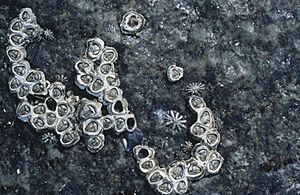Chamaesipho tasmanica facts for kids
Quick facts for kids Chamaesipho tasmanica |
|
|---|---|
| Scientific classification | |
| Kingdom: | |
| Phylum: | |
| Subphylum: | |
| Class: | |
| Infraclass: | |
| Order: |
Sessilia
|
| Suborder: |
Balanomorpha
|
| Superfamily: |
Chthamaloidea
|
| Family: |
Chthamalidae
|
| Subfamily: |
Notochthamalinae
|
| Genus: |
Chamaesipho
|
| Species: |
Chamaesipho tasmanica
Foster & Anderson, 1986: 58
|
Chamaesipho tasmanica is a small barnacle that lives on the rocky shorelines of Australia. It is mostly found in New South Wales and Tasmania. These barnacles often grow close together, forming tall, column-like groups on rocks that don't have much seaweed. Individual barnacles are usually small, less than 15 millimeters (about half an inch) across, and are grayish in color.
What is the Honeycomb Barnacle?
Chamaesipho tasmanica is a tiny barnacle, usually about 10 millimeters wide. This makes it much smaller than some other barnacle species. When many of these barnacles grow together, they form crowded groups that look a bit like a honeycomb. This is why it's sometimes called the honeycomb barnacle.
Like other barnacles, it has special plates that protect its soft body. Two important plates are called the scutum and the tergum. These plates help the barnacle stay safe from predators and harsh waves.
Where Does the Honeycomb Barnacle Live?
The Chamaesipho tasmanica barnacle lives only in Australian waters. You can find it mainly in New South Wales and Tasmania. Its northernmost home is Cape Byron in northern New South Wales. To the west of Tasmania, it has been seen as far as Point Sinclair. It has also been spotted once at Lord Howe Island.
This barnacle prefers to live on rocks in the high intertidal zone. This is the part of the shore that is covered by water at high tide but exposed to the air at low tide. It likes areas that are exposed to waves and does not settle in calm, sheltered spots. It also avoids places covered in seaweed. This is because seaweed can hide predators like whelks, which are snails that eat barnacles.


